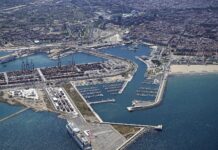
The Port of Rotterdam has installed a smart bollard, developed in collaboration with the mooring and dredging company Straatman BV, along the quay of the Hutchison Ports European Container Terminals (ECT) Delta terminal on the Maasvlakte.
[s2If is_user_logged_in()]By measuring the strain on the mooring lines in real-time, the bollard will allow the real-time monitoring of safety and will provide a clearer picture of which vessels can moor at which quays.
 The smart bollard trial is part of a series of measures aimed at using digital technology to manage highly capital-intensive assets such as quay walls more efficiently.
The smart bollard trial is part of a series of measures aimed at using digital technology to manage highly capital-intensive assets such as quay walls more efficiently.
“Until now, it has not been possible to measure the strain on mooring lines,” the Port of Rotterdam pointed out in its announcement and went on to explain, “The lack of exact data measured on moored vessels meant we had to assume maximum mooring loads exerted on the lines by the vessels and quay walls. These forces vary due to differences in local conditions. The smart bollard can help give us a better understanding of the forces involved.”
When force is applied to a bollard, it moves very slightly, then a sensor measures the force and sends the results directly to the Port of Rotterdam Authority. Before the smart bollard was installed, it was successfully put through its paces on a test bench in Zwijndrecht, the base of Straatamn.
The Port of Rotterdam Authority said it specialises in the construction and maintenance of quay walls, while it manages 80km of quay wall and 200km of bank shoring, monitoring the structures using collected data.
“For example, sensors are installed in many quays and the results have shown that quay walls last much longer than had previously been assumed,” the major Dutch port said.
This research has now resulted in the updating of the European standards for structural design (Eurocodes).[/s2If]
[s2If !is_user_logged_in()]Please login or register to read the rest of the story[/s2If]








